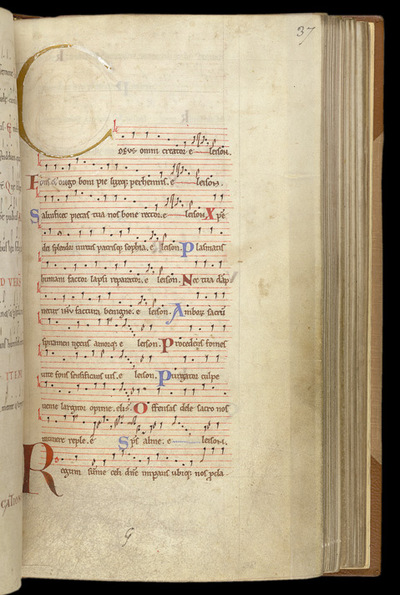Javascript must be enabled to continue!
Musical Notation, in the Caligula Troper
View through Europeana Collections
Made up of fragments from a late Anglo-Saxon
liturgical chant book plus a fragment of a late 12th-century
musical manuscript, the Caligula Troper's illuminations introduce
songs which would be inserted into the mass on special feast days
and sung by a soloist, hence the book's small scale. The pictures'
geometric abstraction of form and use of vibrant colours
embellished with gold give an opulence that speaks of manufacture
for use by an important figure. It is named for its 17th-century
position in a bookcase supporting a bust of Caligula in the Cotton
rare books library. Its selection of tropes (songs) and where it
was in the Middle Ages suggest origins at Winchester or
Worcester.The late 12th-century troper is typical for its time. It
begins with troped kyries (hymns with musical notations) with latin
texts. By this time, musical notation using lines to indicate
specific pitches was in use in England. The 11th-century troper's
musical notation as well as its texts had become outdated soon
after it was made. This suggests that the two fragments of musical
books were bound together fairly soon after the late 12th-century
troper was made.
Title: Musical Notation, in the Caligula Troper
Description:
Made up of fragments from a late Anglo-Saxon
liturgical chant book plus a fragment of a late 12th-century
musical manuscript, the Caligula Troper's illuminations introduce
songs which would be inserted into the mass on special feast days
and sung by a soloist, hence the book's small scale.
The pictures'
geometric abstraction of form and use of vibrant colours
embellished with gold give an opulence that speaks of manufacture
for use by an important figure.
It is named for its 17th-century
position in a bookcase supporting a bust of Caligula in the Cotton
rare books library.
Its selection of tropes (songs) and where it
was in the Middle Ages suggest origins at Winchester or
Worcester.
The late 12th-century troper is typical for its time.
It
begins with troped kyries (hymns with musical notations) with latin
texts.
By this time, musical notation using lines to indicate
specific pitches was in use in England.
The 11th-century troper's
musical notation as well as its texts had become outdated soon
after it was made.
This suggests that the two fragments of musical
books were bound together fairly soon after the late 12th-century
troper was made.
Related Results
St Andrew, in the Caligula Troper
St Andrew, in the Caligula Troper
Made up of fragments from a late Anglo-Saxon
liturgical chant book, the Caligula Troper's illuminations
introduce songs which would be inserted into the mass on special
feast days ...
The Naming of St John the Baptist, in the Caligula
Troper
The Naming of St John the Baptist, in the Caligula
Troper
Made up of fragments from a late Anglo-Saxon
liturgical chant book, the Caligula Troper's illuminations
introduce songs which would be inserted into the mass on special
feast days ...
The Ascension, in the Caligula Troper
The Ascension, in the Caligula Troper
Made up of fragments from a late Anglo-Saxon
liturgical chant book, the Caligula Troper's illuminations
introduce songs which would be inserted into the mass on special
feast days ...
St Stephen as a Deacon, in the Caligula Troper
St Stephen as a Deacon, in the Caligula Troper
Made up of fragments from a late Anglo-Saxon
liturgical chant book, the Caligula Troper's illuminations
introduce songs which would be inserted into the mass on special
feast days ...
St Peter's Release From Prison, in the Caligula
Troper
St Peter's Release From Prison, in the Caligula
Troper
Made up of fragments from a late Anglo-Saxon
liturgical chant book, the Caligula Troper's illuminations
introduce songs which would be inserted into the mass on special
feast days ...
St Lawrence, in the Caligula Troper
St Lawrence, in the Caligula Troper
Made up of fragments from a late Anglo-Saxon
liturgical chant book, the Caligula Troper's illuminations
introduce songs which would be inserted into the mass on special
feast days ...
Temptation of St Martin, in the Caligula Troper
Temptation of St Martin, in the Caligula Troper
Made up of fragments from a late Anglo-Saxon
liturgical chant book, the Caligula Troper's illuminations
introduce songs which would be inserted into the mass on special
feast days ...
The Wise Virgins, in the Caligula Troper
The Wise Virgins, in the Caligula Troper
Made up of fragments from a late Anglo-Saxon
liturgical chant book, the Caligula Troper's illuminations
introduce songs which would be inserted into the mass on special
feast days ...




